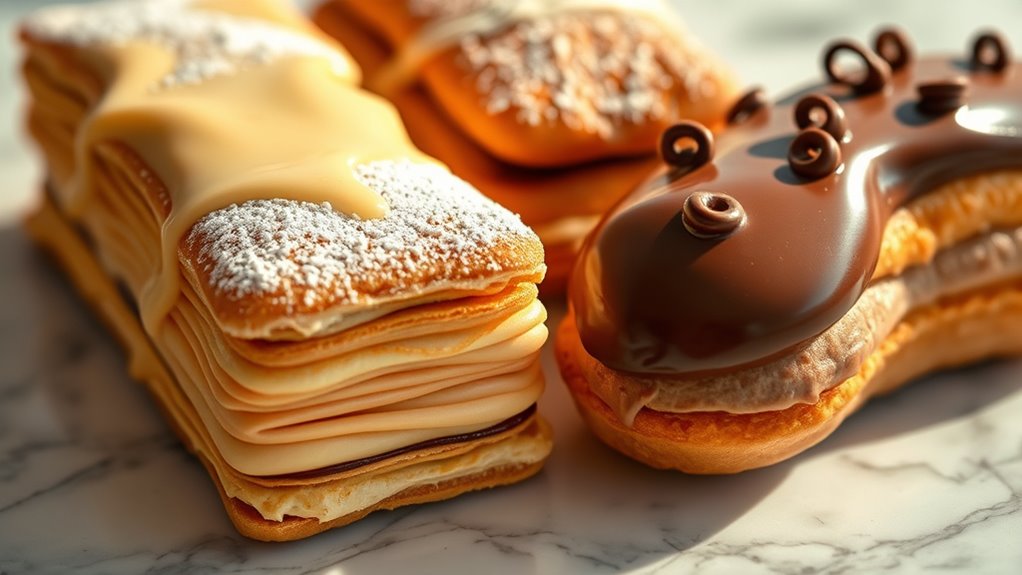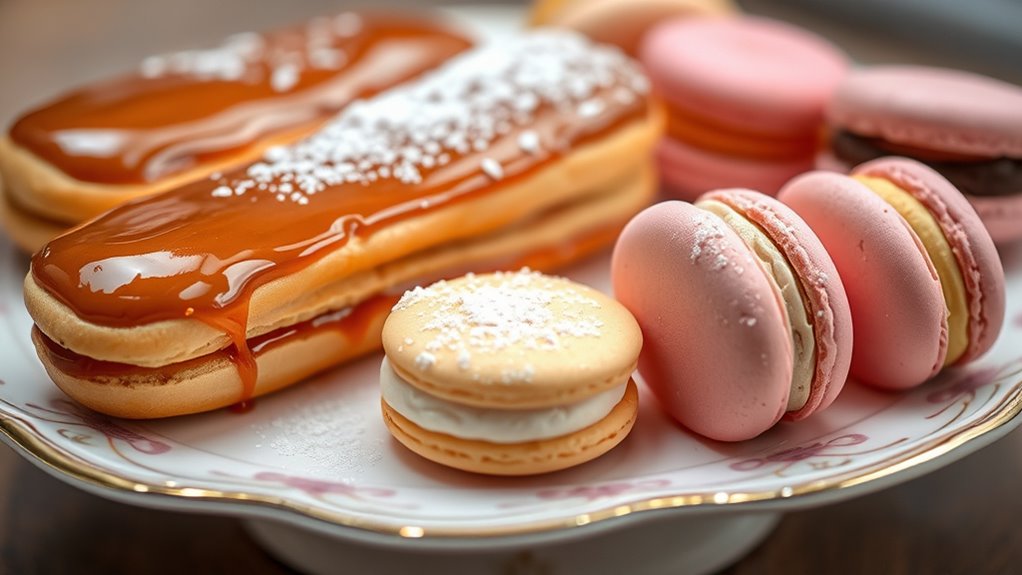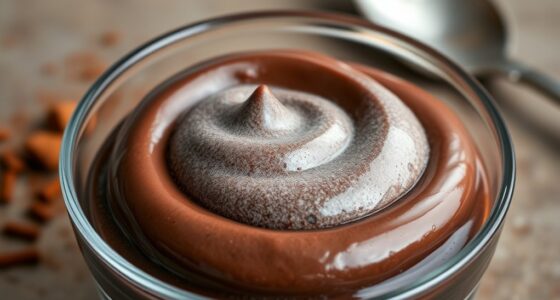French desserts showcase refined craftsmanship, delicate flavors, and beautiful presentation, shaping global pastry traditions. You’ll notice their emphasis on harmony, fresh high-quality ingredients, and intricate techniques like lamination and tempering. These desserts serve as symbols of elegance and cultural heritage while inspiring creative innovations worldwide. Their influence is seen in treats like macarons, croissants, and tarts. Exploring this art further reveals how French pastry masters blend tradition with artistry to create memorable culinary experiences.
Key Takeaways
- French desserts exemplify delicate flavors, elegant presentation, and harmonious textures, influencing global pastry traditions.
- Mastery of techniques like lamination and tempering ensures refined, high-quality French confections.
- Use of fresh, natural ingredients highlights the balance and sophistication characteristic of French patisserie.
- French desserts serve as cultural symbols, inspiring international culinary artistry and creative expression.
- Their evolution reflects a blend of tradition and innovation, shaping the global art of pastry-making.

French desserts, or patisserie, are renowned for their delicate flavors and exquisite presentation. When you indulge in these treats, you’re experiencing centuries of culinary artistry crafted with precision and passion. Each pastry, tart, or éclair isn’t just about taste; it’s about the harmony of textures, colors, and aromas that come together to delight your senses.
French pastry chefs have perfected their craft through generations, transforming simple ingredients into masterpieces that elevate dessert making into an art form.
You’ll notice that French desserts emphasize balance. The sweetness never overshadows the subtleties of the ingredients, and each element plays a crucial role. For example, a perfectly flaky croissant combines buttery layers with a crisp exterior, while a tartelette’s crisp shell cradles a smooth, tangy filling. These desserts often use fresh, high-quality ingredients, like ripe berries, rich creams, and fragrant vanilla, which highlight their natural flavors.
This focus on quality and finesse defines French pâtisserie and influences pastry traditions worldwide. The techniques involved in crafting these desserts demonstrate a mastery of skill and precision that has been cultivated over centuries.
French desserts also showcase a mastery of techniques that you can admire or aspire to learn. The delicate lamination of dough for croissants and mille-feuille requires patience and skill, creating layers that are light yet buttery. Pastry chefs use precise tempering methods for chocolates and glazes, ensuring the glossy finish that makes desserts visually stunning.
The art of piping decorations, such as rosettes on éclairs or intricate designs on petits fours, demonstrates meticulous attention to detail. These techniques aren’t just for aesthetics—they enhance the overall experience, making each bite a sensory delight.
The influence of French desserts extends far beyond France’s borders. You’ve likely encountered French-inspired pastries in bakeries worldwide, from the classic macarons to delicate madeleines. Many chefs incorporate French techniques into their own creations, blending tradition with innovation.
This global reach has helped elevate the status of pastry arts, inspiring countless bakers to pursue perfection and creativity. French desserts have become symbols of elegance and celebration, often featured at weddings, holidays, and special occasions, emphasizing their cultural significance.
Ultimately, the art of patisserie is about more than just making desserts; it’s about creating an experience. When you savor a French pastry, you partake in a rich tradition that celebrates craftsmanship, attention to detail, and a passion for beauty and flavor.
It’s an art form that continues to evolve while honoring its history, inspiring chefs and dessert lovers alike to appreciate the delicate balance between simplicity and sophistication.
Frequently Asked Questions
How Do Regional French Desserts Vary Across France?
You’ll notice that regional French desserts vary based on local ingredients and traditions. In Provence, you might enjoy lavender-infused confections.
While in Brittany, rich butter and caramel flavors dominate. In the Alps, hearty alpine treats like tartiflette are popular.
Whereas in the Southwest, you’ll find sweet, nutty Basque cakes. These regional differences give each area its own unique dessert style, reflecting local culture and history.
What Are the Key Ingredients in Traditional French Patisserie?
Imagine a symphony of flavors where butter, sugar, eggs, and flour take center stage. In traditional French patisserie, these ingredients are your melody, harmonized with vanilla, chocolate, and fresh fruits.
You’ll also find subtle hints of almond or lemon zest that add depth. These essentials come together with finesse, creating delicate textures and rich tastes that make each dessert a true culinary masterpiece.
How Has French Pâtisserie Influenced Global Dessert Trends?
French pâtisserie has considerably shaped global dessert trends by introducing refined techniques, elegant presentation, and classic flavors. You’ll notice how many modern desserts incorporate French elements like flaky croissants, delicate éclairs, and rich mousses.
French pastry chefs inspire you to elevate your creations with precision and artistry. This influence encourages innovation while respecting tradition, making French desserts a timeless benchmark for quality and sophistication worldwide.
What Techniques Distinguish French Pastry Craftsmanship?
You notice that French pastry craftsmanship stands out for its precise techniques. You master lamination to create flaky layers in croissants, and you understand the importance of tempering chocolate for glossy finishes.
You also learn to perfect pâte à choux for éclairs and profiteroles, and you pay attention to perfecting the art of sugar work and piping. These techniques elevate your desserts, showcasing your skill and attention to detail.
How Can I Replicate Authentic French Desserts at Home?
To replicate authentic French desserts at home, start by sourcing quality ingredients like butter, cream, and fresh fruit.
Follow traditional recipes closely, paying attention to techniques like tempering chocolate or folding batter gently.
Practice patience and precision, and don’t rush the process.
Use proper tools, such as piping bags and silicone molds, to achieve professional-looking results.
With dedication, you’ll master the art of French patisserie and impress everyone with your skills.
Conclusion
You now know how French desserts have shaped global patisserie, blending tradition with innovation. Did you know that France exports over 1.2 billion euros worth of pastries annually? That’s a proof to their timeless appeal and influence. So, next time you indulge in a flaky croissant or delicate éclair, remember you’re tasting centuries of artistry. Embrace the art of patisserie—it’s a delicious journey that continues to inspire chefs worldwide.









